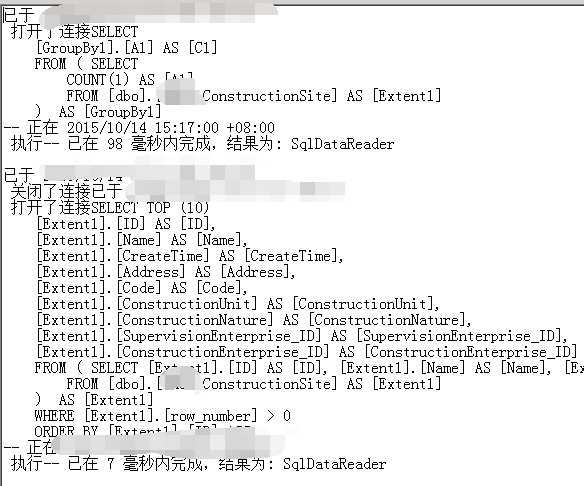标签:
今天我们来聊聊EF的日志记录.
一个好的数据库操作记录不仅仅可以帮你记录用户的操作,
更应该可以帮助你获得效率低下的语句来帮你提高运行效率
废话不多说,我们开始
系统:WIN7
数据库:SQL Server2008
相关技术:MVC5 EF6.0+
一、修改配置文件
我们先来看看最简化的EF日志记录,任何代码都不用改,在你的配置文件中加入如下配置即可自动记录:
在你的EntityFramework节点下加入如下配置即可(这里需要注意的是第一个参数是你日志的输出地址):
<interceptors>
<interceptor type="System.Data.Entity.Infrastructure.Interception.DatabaseLogger, EntityFramework">
<parameters>
<parameter value="D:\ttt\log.txt" />
<parameter value="true" type="System.Boolean" />
</parameters>
</interceptor>
</interceptors>
我们到对应的地址下就能找相关的日志文件了如下:

二、简单封装:
编写一个自己的DBContext的基类如下:
public class DataBaseContext<T> : DbContext where T:class,new()
{
//重写SaveChanges方法
public override int SaveChanges()
{
string sql = "";
//记录实体操作日志
this.Database.Log = (a) =>
{
sql += a;
};
//这里的sql就是操作日志了,想记哪就记哪吧.这里我就不实现了.
return base.SaveChanges();
}
}
如果你只是想单纯的记录,上面两种方式应该就能满足你了.
我们记录的目的其实最重要的还是在于分析性能 下面就开始我们的重头戏.
采用IDbCommandInterceptor接口进行EF的监听
首先我们来看看这个接口里面到底有些什么:

写过ADO.NET的人 应该对这些单词很熟悉了吧.(因为EF最终访问数据库的方式还是用的ADO.NET)
注意:每个执行都有ed(执行完成后的监听)和ing(执行时的监听)
下面我们来一步一步实现这个接口
首先定义一个类(名字你随意):
//名字可以随意,但是肯定要继承我们的监听接口 - - ,
public class DatabaseLogger : IDbCommandInterceptor
{
}
然后我们继续,
定义一个静态只读的ConcurrentDictionary作为我们的记录仓储,考虑到数据访问时多线程的情况很常见,所以我们采用线程安全的ConcurrentDictionary
代码如下:
public class DatabaseLogger : IDbCommandInterceptor
{
static readonly ConcurrentDictionary<DbCommand, DateTime> MStartTime = new ConcurrentDictionary<DbCommand, DateTime>();
}
接下来,我们来实现我们所需要的两个方法 一个为onStart来记录SQL语句执行开始的时间
如下:
//记录开始执行时的时间
private static void OnStart(DbCommand command)
{
MStartTime.TryAdd(command, DateTime.Now);
}
然后实现我们的log方法来记录相关的SQL语句和错误信息
private static void Log<T>(DbCommand command, DbCommandInterceptionContext<T> interceptionContext)
{
DateTime startTime;
TimeSpan duration;
//得到此command的开始时间
MStartTime.TryRemove(command, out startTime);
if (startTime != default(DateTime))
{
duration = DateTime.Now - startTime;
}
else
duration = TimeSpan.Zero;
var parameters = new StringBuilder();
//循环获取执行语句的参数值
foreach (DbParameter param in command.Parameters)
{
parameters.AppendLine(param.ParameterName + " " + param.DbType + " = " + param.Value);
}
//判断语句是否执行时间超过1秒或是否有错
if (duration.TotalSeconds > 1 || interceptionContext.Exception!=null)
{
//这里编写记录执行超长时间SQL语句和错误信息的代码
}
else
{
//这里编写你自己记录普通SQL语句的代码
}
}
既然我们已经得到了想要的东西,那具体的记录方式,各位仁者见仁 智者见智 就随意了,所以我这就不写了.
然后接着,我们要实现这个接口的6个方法,如下:
public void NonQueryExecuted(DbCommand command, DbCommandInterceptionContext<int> interceptionContext)
{
Log(command, interceptionContext);
}
public void NonQueryExecuting(DbCommand command, DbCommandInterceptionContext<int> interceptionContext)
{
OnStart(command);
}
public void ReaderExecuted(DbCommand command, DbCommandInterceptionContext<DbDataReader> interceptionContext)
{
Log(command, interceptionContext);
}
public void ReaderExecuting(DbCommand command, DbCommandInterceptionContext<DbDataReader> interceptionContext)
{
OnStart(command);
}
public void ScalarExecuted(DbCommand command, DbCommandInterceptionContext<object> interceptionContext)
{
Log(command, interceptionContext);
}
public void ScalarExecuting(DbCommand command, DbCommandInterceptionContext<object> interceptionContext)
{
OnStart(command);
}
其实很简单,就是所有的ing执行我们之前写的OnStart方法,所有的ed执行我们的log方法即可.
接下来,我们需要注入这个接口:
这里我的Demo用的MVC所以我就在 Application_Start()中直接注入了,如下:
protected void Application_Start()
{
//注入自己写的监听
DbInterception.Add(new MiniProfiler_EFModel.DatabaseLogger());
}
这样我们就完成了整个监听的过程了~
实现效果如下:
我们得到了执行的秒数

得到了执行的SQL语句:

得到了SQL语句所对应的参数:

大功告成!
这里我只是帮各位通过监听来获取到相关的信息,具体如何优化,应该用什么东西进行记录,我就不过多的赘述,这是属于仁者见仁智者见智的东西,不过有兴趣的可以通过博客加我QQ进行讨论.欢迎.
EntityFramework的多种记录日志方式,记录错误并分析执行时间过长原因(系列4)
标签:
原文地址:http://www.cnblogs.com/shiningrise/p/5585149.html